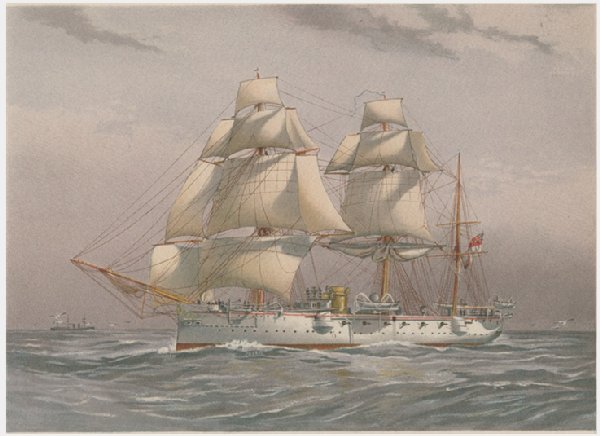
On January 25th, 1887, WIT joined the newly commissioned HMS Calliope under Captain Henry Coey Kane and was soon promoted to the rating of Petty Officer, 2nd Class, and the duty 'Second Captain of the Fore Top'. This meant he was in charge of one of the watches to go aloft and manage the topsail (the second sail in order upwards) on the fore mast (the leading mast of the ship). During the commissioning voyage which would include the hurricane at Apia, WIT was seriously injured in an accident at Cape Town outward bound, but elected to stay with his ship and recuperate on board, rather than stay in the hospital and when fit, try and catch up with Calliope on other British warships passing through. Though he recovered a great deal, the injury would eventually end his naval career when Calliope returned to England in April 1890.

The colour image of Calliope is one of a number of colour plates published in the book "Her Majesty's Navy" by Charles Rathbone Low in three volumes (1890), which is expensive and hard to find complete. I think there are supposed to be 45 or 46 plates in the complete set, depending on whether the frontispiece is counted or not. Many copies were broken up and the plates sold separately for more money overall, and many apparently complete copies have an incomplete set of plates. Scaramouche purchased the plate shown here in an E-Bay auction. It seems to be original, though I suspect it may be hard to be sure. The image was a painting by either W. Christian Symons or W. Fred Mitchell, who both illustrated the book's volumes.
Calliope left Plymouth on Saturday 5th March, 1887 for her voyage to the China station by way of the Cape of Good Hope. She sailed across the Bay of Biscay and down the Atlantic coastline of Africa, crossing the line, and touching Tristan da Cunha before entering Simon's Bay at Simon's Town at the southern tip of Africa. She then sailed across the Indian ocean, well to the south of that continent, and up through the Sunda Straight to Singapore, crossing the line again. She sailed on to Hong Kong, then Japan where she met up with the fleet. Sailing around Japan and the Pacific sea board of Russia, she was told off for the Australia Station. She left the fleet and sailed down the passage again crossing the equator and arriving at Sydney on 15th November 1887.
She spent much of her time sailing around the coast of Australia, New Zealand, and the South Sea Islands. On 21st January, 1889, she left Sydney for her third and fateful visit to Apia Samoa.
After the events of the storm described in the page about it, and Calliope's escape, she returned to Sydney on 4th April, 1889 and after repair again sailed around the Pacific Islands. On Wednesday, October 2nd 1889, she left Sydney for her journey home via Singapore and the Suez Canal.
When Calliope reached Port Said at the Mediterranean end of the Suez Canal, having crossed the equator for the fourth time, she was met with new orders to return through the canal to Aden, and from there to join the British East Indies Squadron at Zanzibar for a possible war with Portugal.
The war never materialised, and on 10th February, 1890 Calliope was given her orders to continue her journey home, to cross the equator for the sixth time. Despite some further adventures, she eventually reached Plymouth on 7th April 1890, continuing on to Portsmouth and arriving later that evening.
Calliope was paid off on 30th April, 1890 after a voyage that had lasted more than 3 years. For more details about the voyage, the statistics and a map, see the page "Map".